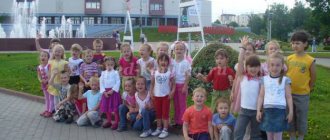Family project in the senior group of kindergarten on the topic: “Little discoveries in my big family”
You and I are growing up in a family circle
The basis of the foundations is the parental home.
All your roots are in the family circle,
And you come into life from family.
In the family circle we create life,
The basis of the foundations is the parental home.
There has been a lot of talk about traditions lately. These are loud words about “the revival of traditions and increasing the level of self-awareness of the nation,” and amazing stories about the customs of other countries, and advertising where everything is always traditional. Everyone knows that in Rus' all families had their own traditions, which united them, making them strong and strong. But, after November 7, 1917, the day of the October Revolution, many traditions were abolished, both folk and family.
Some, of course, remained, transformed. Some have sunk into oblivion. And, of course, new ones appeared. Views on the concept of “family,” on family loyalty, and on raising children have also changed. Many of the traditions that made a family a family were lost. Many families to this day are more reminiscent of people who live under the same roof, while having nothing in common, and sometimes even not knowing each other. But it is the family that gives a sense of stability and protection from early childhood, which we carry throughout our adult lives and pass on to our children, and so on from generation to generation, gaining wisdom and experience. Therefore, traditions are the basis of the way of life of a family, a family that is friendly, strong, and has a future. That’s why we need to revive traditions, family traditions. It’s good if all family members like them, because they are capable of bringing closer together, strengthening love, instilling mutual respect and understanding in the souls, something that is sorely lacking in most modern families. Children are raised not only by their parents as such, but also by the family life that develops. You can become involved in family traditions through the personal example of the parents themselves. It is with the family that the introduction to culture begins; the child masters the basics of material and spiritual culture. In a family environment, human forms of behavior are also formed: thinking and speech, orientation in the world of objects and relationships, moral qualities, aspirations, ideals.
The function of a kindergarten is the purposeful socialization of a child’s personality: introducing him to the world of natural and human connections and relationships, transferring to him the best examples, methods and norms of behavior in all spheres of life. Our kindergarten is attended by children of different nationalities: Russians, Buryats, Ukrainians, Tatars, Armenians, etc. The emphasis is on the fact that we are all different, but we have common interests, we need each other for a meaningful, interesting, kind life together. This is how the idea of implementing a project under the general name was born
Type of project: adult-children, cognitive-speech, creative.
Problem: In modern society, characterized by high activity, mental expenditure, and a lack of human warmth and attention, the connection between generations is lost, the family ceases to be a fortress and support for its members, traditions, customs, and the past are forgotten. The educational potential of the family is gradually weakening. But even ancient teachers believed that children should be raised with love and respect for their parents and veneration of ancestors, and to raise a future family man from an early age. I really want the thread connecting people in family relationships to be a thick rope capable of holding the entire family together.
Relevance: Raising a harmoniously developed personality is a priority in the new Law on Education. Such development is possible only in close cooperation between the preschool educational organization and the family. In connection with this, the need arose to develop this project for the development of family traditions.
Goal: to deepen children’s knowledge about the composition of their family, ancestry and family traditions.
Tasks:
— clarify and deepen children’s knowledge about their relatives, family ties and family members;
— give children the idea that each family is individual, has its own history, traditions, interests and foundations;
— create conditions to maintain interest for successful completion of the task;
— develop children’s cognitive-search activity;
— enrich parent-child relationships with the experience of creative activity;
— develop children’s speech skills to conduct a monologue and dialogue, talk about themselves, their family, using their personal experience;
— cultivate love and respect for your loved ones.
Project duration: one month.
Project participants: children of the senior group, their parents, group teacher.
Expected results: This project will help reveal to the child the world of national cultures, expand ideas about the way of life of the people inhabiting their native village, their customs and traditions, folklore; on the basis of cognition, promote the speech, artistic, aesthetic, moral, emotional and social development of children. By introducing children to the culture of their people and the nationalities living nearby, to form their idea of themselves and others as individuals. Fostering a sense of pride in students for their family, love for each family member; knowledge of your family history, family traditions and holidays. Creation of a system of joint activities: “child - teacher” and “child - parent” on this problem.
I assume that the main criterion for the effectiveness of this project will be the activity of parents in all activities carried out within the framework of this project, as well as the completeness and strength of children’s knowledge about the traditions of their family and their people.
Project implementation plan.
| 1st stage. Preparatory. | ||
| Name of the event. | Category of participants | Products of activity. Note. |
| Selection and study of literature and materials on the project topic: “Little discoveries in my big family” | Teacher Parents | List of references used (Appendix No. 1). List of children's fiction recommended for parents (Appendix No. 2) |
| Organization of an exhibition of children's fiction. | Parents Teacher | Exhibition of children's fiction (Appendix No. 3) |
| Development of a plan for a thematic week on the topic: “Family” | Educator | Appendix No. 4 |
| Consultation for parents: “The role of family traditions in raising children” | Teacher Parents | Appendix No. 5 |
| 2nd stage. Basic. | ||
| Event name | Category of participants | Product of innovation activity |
| Making an information sheet for parents: “What’s in my name...” | Educator | Appendix No. 6 |
| Conversations with children about family and family traditions. | Children Teacher | |
| Review of a presentation on the topic: “Family Heirlooms” | Children Teacher | Appendix No. 8 |
| Children's stories about their family tree. | Children Teacher | |
| Organization of joint play activities for children. | Children Teacher | |
| Productive activities of children. Decorative drawing “Gift for Grandma.” | Children Teacher | Abstract Appendix No. 11 |
| Productive activity. Application “Bird of Happiness”. | Children Teacher | Abstract Appendix No. 12 |
| Productive activity. Modeling “My Mommy” | Children Teacher | Abstract Appendix No. 13 |
| 3rd stage. Project presentation. | ||
| Mini-stories from parents on the topic: “Why did you name your child that name.” | Parents Teacher | |
| Family poetry evening. | Parents Children Educator | |
| Competition "Tender Treatment" | Parents Children Educator | |
| Children give gifts to their family members. | Children Parents Educator | |
The full version of the work is available.
What is a family business?
Many successful world-famous corporations began as small family businesses. A family business is a type of business activity in which a family or related people are involved.
The advantages of projects of this type include:
- the interest of each partner in the success of the enterprise;
- high level of trust between family members;
- maintaining trade secrets of business and new ideas;
- simple and effective organizational structure;
- pooling start-up capital of relatives;
- understanding patterns of behavior between family members;
- the prospect of working “for yourself” without hiring staff.
Before implementing the idea of a family business, you need to remember the disadvantages of such cooperation. These include the likelihood of conflicts between relatives, the difficulty of making management decisions due to lack of subordination, the struggle for leadership, and neglect of responsibilities.
Important! It is advisable to implement family projects by close-knit teams of relatives who are able to distinguish personal relationships from professional ones, adhere to the established hierarchy, and equally strive to achieve success.
The best small family business ideas
Collaborative work between relatives should begin with a small project. This will allow you to evaluate commercial benefits and the ability to work for a common cause. There are a huge number of family business ideas. You need to choose a suitable industry, market niche, product or service and decide on the amount of starting capital. The nuances of the project should be analyzed, assessed and written into the business plan.
Services sector
Covers such areas of work as organizing holidays, providing tourism services, carrying out repairs, and services in the beauty industry.
What kind of enterprise can be organized:
- Restoration of bathtubs with acrylic. The markup is 50%, minimal investment, large average bill. It is necessary to purchase consumables, tools, and protective clothing. Disadvantages include the harmful health effects of the coating process and the fact that only men can do the work.
- Sewing workshop. They provide repair and tailoring services for custom-made clothes. It is necessary to rent a spacious room and obtain permits. You need to buy sewing equipment, supplies, fittings, and fabrics. It is advisable to have experience in the specialization of cutting and sewing, clothing design.
- Upgrade and repair of computer and mobile equipment. The enterprise's income is from 100 thousand rubles per month, but there is high competition in the niche. You need to find suppliers of parts and software, and have the skills to repair PCs, laptops, smartphones, and tablets.
A family firm can provide advocacy and legal services, transport passengers and cargo, and courier delivery of parcels. As an option, it is worth considering the idea of organizing children's parties, opening a beauty salon, or a dental office.
Trade
A group of relatives can engage in retail sales, making a profit in the form of a trade margin. To work, you need to choose what to sell, to whom, at what cost.
Popular options for organizing a business in trade:
- Online store. This type of entrepreneurial activity is characterized by small investments at the start. If you have to sell an expensive product, you can work on pre-order. It is necessary to create a website with a colorful and detailed product catalog, constantly maintain contact with the target audience, and set up online advertising.
- Offline point of sale. For a store, you should rent or buy premises in a shopping center or a separate building - it depends on the concept of the enterprise. You can trade food, household chemicals, dishes, furniture, building materials, clothing, bed linen, etc.
- Franchise work. Many well-known companies provide the opportunity to sell their products for a fee. In return, the partner provides consulting support for the business and provides advertising materials. An important condition is to sell only the goods specified in the franchise agreement.
Another trading option is dropshipping. The company sells products directly from the manufacturer to the consumer without intermediate storage of goods in a warehouse. The owner of an online store sells other people's products under his own brand and makes a profit on the difference in price or a percentage of sales.







